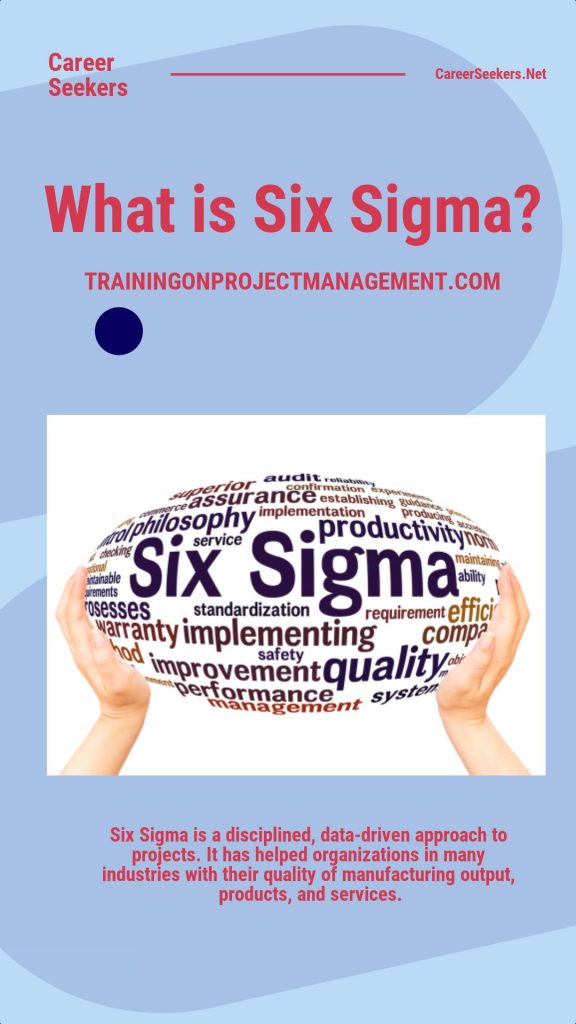Six Sigma Certification is a quality management program that helps you make more money by reducing waste and improving processes. Learn how to earn your Lean Six Sigma Green Belt or Black Belt Certification and what training you need to help get certified and placed in your career
Six Sigma Belt Certifications Training| Lean 6 Sigma Project Manager Courses and Certification
Lean Six Sigma is one of the best-known and most popular certifications for managers but is not as popular as it was in the ’90s when Jack Welch, the former CEO of General Electric helped to popularize it by making it the central business strategy of General Electric. It is still sought after in certain industries including production, manufacturing, logistics, engineering, and finance. If you are interested in learning Lean Six Sigma, it can be confusing with all the belt levels that make you think you are in a martial arts studio. Which one should you get? That will depend on a few factors, but right off the bat, I can tell you that for most people, there are just 3 to be concerned with (yellow, green, and black). if you are unemployed and looking for one that will help you get a job, we can narrow this down to just two: Either Green Belt or Black Belt. Keep reading to learn why.
Table of Contents
What is Six Sigma?
Six Sigma is a disciplined, data-driven approach to projects. It has helped organizations in many industries with their quality of manufacturing output, products, and services. Six Sigma has been used by big enterprises such as Amazon, 3M, Boeing, etc…
Six Sigma is a collection of strategies and tools that are designed to increase business efficiency. Six Sigma training is available that will help you implement Six Sigma process improvements in your company. Six Sigma helps improve the quality of your business processes by helping you identify and fix any errors. Six Sigma is useful for many organizations, including manufacturing operations, logistics, and retail operations.
The Six Sigma approach is equally applicable to IT and any other business process. Project managers, as well as IT department managers, can use the Six Sigma approach to improve service levels, reduce downtime, and optimize processes.
During the “Define” phase of Six Sigma, the problem to be solved is defined so that it can be identified as a problem that can be solved with the Six Sigma methodologies.
The “Measure” phase of Six Sigma includes data collection, analysis, and measurement as well as taking corrective actions to identify root causes of problems.
The “Analyze” phase of Six Sigma includes the analysis and interpretation of data collected during the previous phases so that actionable insights can be gained and improvements can be made to solve problems.
The “Improve” phase includes continuous improvement of processes, products, or services through the implementation of new methods that are not yet fully proven.
The “Control” phase of Six Sigma includes the implementation and adherence to actions identified during previous phases.

Six Sigma and Lean: The Difference
It is important to understand the differences between Six Sigma and Lean in order to understand LSS. Both systems are meant to streamline production and improve processes, but people often confuse them. Many companies combine them to get the best results. Although they share many similarities, companies should understand the differences between them.
Six Sigma is a statistical quality control system. Six Sigma helps improve business processes by eliminating wasteful and defective activities. Six Sigma uses data to create products and improve results. Defective items can lead to waste. Although the original intent of Six Sigma was to be used in manufacturing, companies discovered it could be applied to all aspects of their operations. For example, a company might try to achieve near-perfect results in customer service and deliveries.
Six Sigma is focused on eliminating defects and waste in order to create near-flawless products. Lean, however, emphasizes reducing wasteful and unnecessary steps throughout a product’s creation. This system focuses on reducing the number of steps necessary to create a product. The Lean methodology evaluates whether a step adds value to the product and determines what is worth paying for. To ensure that your production processes are efficient and profitable, customers won’t pay extra for any steps.
Why is LSS Certification Important?
Six Sigma and Lean certifications can be valuable by themselves — certified individuals in these strategies will help companies implement these strategies throughout their organization. LSS certification is a great way to maximize the benefits. LSS certification enables individuals to learn how to use both systems to increase efficiency and decrease waste.
Lean Six Sigma Certifications
Six Sigma and Lean are two of the most effective systems for streamlining key business processes in manufacturing. Although Six Sigma and Lean are different systems, both have the same goal: to reduce waste and increase efficiency. Some companies use both systems to achieve their goals, while others combine them to improve their business. Lean Six Sigma (LSS), certifications are particularly valuable in the manufacturing industry, because certified employees can use both systems to their best advantage.
We will discuss LSS certification and the certification levels that are associated with this standardization process.
Top reasons to get a Lean Six Sigma certification
Lean Six Sigma is an internationally recognized project management methodology that has transformed organizations. Certified Lean Six Sigma professionals help optimize processes and systems across industries, which can lead to opportunities for advancement in your career.
The top reasons for getting certified are the fast recognition of Lean Six Sigma worldwide, the ability to transform an organization using Lean Six Sigma Methodologies, and the opportunity to advance your skillset by gaining knowledge in this powerful approach.
What is Lean Six Sigma?
Lean Six Sigma refers to the relentless and consistent reduction of waste (Lean), and variation (Six Sigma), in critical processes within an organization that have an impact on revenues and costs as well as stakeholder satisfaction. This can be used in both manufacturing and services industries to reduce defects, production, wait time, inventory, processing, and other issues.
Lean Six Sigma is a process that reduces waste and variation in business processes that have an impact on revenue and costs. Six Sigma allows organizations to improve their processes by identifying the causes of errors and working to correct them. Numerous companies have used the Six Sigma process improvement method to improve efficiency, reduce costs, and increase customer satisfaction.
Benefits of Lean Six Sigma
A Six Sigma certification can benefit any job role, from HR and IT to Sales and Marketing. Lean Six Sigma knowledge can play a vital role in delivering quality products/services. Examples of job roles that benefit from Lean Six Sigma: HR and IT, Sales and Marketing, Customer Service, Accounting, Manufacturing, Operations, and Quality Assurance. Some of the benefits to organizations with Six Sigma Certified Professionals are
- Improve their performance by reducing defects in the process.
- Increase customer satisfaction
- Enhance profitability.
If you’re looking to boost your career with business acumen and analytical skills, then Six Sigma is the way to go. It can help your company become more competitive in your industry by improving processes that are already established or creating new ones.
Skills you will gain
Six Sigma is a project management certification. People who earn these certifications are able to better manage their projects, which can lead to increased productivity and effectiveness of the company as well as individual employees.
This training will teach you about Six Sigma’s success factors, how it works in practice with case studies, and more importantly what skills you’ll gain from this process that help your career progression. Some of the skills you will gain as a result of this program include:
– Managing Business Processes
– Leadership and Team Management Skills
– Marketing Skills

Benefits For Organizations To Have Lean Six Sigma Certified Professionals
An organization’s goal is to improve processes and systems by decreasing business errors. The Six Sigma Methodologies were developed specifically for this purpose, which allows the six sigma process to transform an organization by identifying and eliminating errors.
A Six Sigma Professional can help across any industry optimize any process or system leading to both hard and soft savings. Certified Six Sigma Professionals have expertise in transforming processes within organizations which leads to both hard savings (costs) as well as soft savings (time).
Organizations are experiencing the benefits of having Six Sigma professionals in their organization. For example, when someone is being laid off, there’s a greater need for Six Sigma professionals to handle the project management and find ways to mitigate risk while still meeting deadlines so that production can continue without interruption or delays.

Job Opportunities with Lean Six Sigma Certification
Six Sigma certifications help someone land their dream job. It is one of the most sought-after certifications in project management, and HR sees the Six Sigma qualification as a top item on your resume stack. Other benefits of earning Lean Six Sigma include enhanced communication skills, stronger ability to think creatively, increased problem-solving capacity, better performance during crises, and improved leadership potential.
Industries that use Lean Six Sigma
The Six Sigma certification is becoming more and more common in industries across the board. Fortune 500 companies value Lean Six Sigma methodologies, which are used to develop ideas for process improvements that increase efficiency and effectiveness. The Six Sigma certification is becoming more and more common in industries across the board. Fortune 500 companies value Lean Six Sigma methodologies, which are used to develop ideas for process improvements that increase efficiency and effectiveness. Professionals can be employed in these industries with a Lean Six Sigma certification, depending on their skill set:
– Quality assurance and quality control
– Engineering
– Pharmaceutical
– Manufacturing
– General management
– Finance
– Technology
– Service Industries
How much do managers with Six Sigma make?
According to salary.com, the average Six Sigma Green Belt salary in the United States is $107,900 as of October 29, 2021, but the range typically falls between $87,600 and $114,100. The average Six Sigma Black Belt salary in the United States is $123,800 as of October 29, 2021, but the range typically falls between $106,200 and $133,300. Salary ranges can vary widely depending on many important factors, including education, certifications, additional skills, the number of years you have spent in your profession and location where you live.
Which Lean Six Sigma certification should I start with?
If you are working and will not be leading any teams, but want to be familiar with Six Sigma concepts, then a yellow belt may be all you need. If you want a certification that will boost your career but do not have much experience with Lean Six Sigma, then start with Green Belt. If you already have a Green Belt or equivalent knowledge and/or experience, then go with the Black Belt.

Lean Six Sigma (LSS) Certification Levels
Six Sigma is a process improvement method that was developed by Motorola and has been accepted within the manufacturing industry. The goal of Six Sigma is to reduce defects and improve quality in products and services. There are six levels: White Belt, Yellow Belt, Green Belt, Black belt, Master Black Belt, and Champion.
Because the levels are based upon the Judo Martial Arts system, this is why they sound like martial arts levels. These levels show the level of experience and the role they can play in managing and completing LSS projects.
You can learn more about each level of LSS certification if you are interested in pursuing it.
The belts that are the most in-demand and are most likely to help people get jobs are the Black belt and Green belt..
Champion
The highest level of LSS certification, a Champion, is awarded to individuals with significant experience and leadership in LSS deployment and strategy. The Champion-level position is a managerial role that oversees LSS projects and ensures all initiatives are in line with company objectives. They often work closely with Master Black Belts to direct projects and mentor and guide lower-level people in the implementation of LSS principles. This certification is not in high demand by employers.
Master Black Belt
Master Black Belts are one step below Champions. Black Belts require that an individual has mastered LSS principles. Master Black Belts add experience in leadership, problem-solving, and management to this knowledge. Master Black Belts can take on leadership roles in projects and will adopt a broad view of LSS strategy to ensure that the principles are applied in a manner that is compatible with a company’s structure. In addition to this, Master Black Belts can also coach lower-level employees. This certification is in moderate demand. The black belt is sufficient for most people.
Black Belt
Black Belt certification is the highest level of Lean Six Sigma certification. Black Belt certified professionals are experts in Lean Six Sigma strategies. They have completed years of coursework and gained on-the-job training. Black Belts are distinguished by their proficiency in LSS principles and their ability to analyze, plan and lead projects that meet organizational needs.
Black Belt-level courses often require professionals to show their knowledge and gain experience through the conduct of a project or Practicum. They will use statistical analysis and implementation strategies to apply LSS principles.
Black Belts are more involved in project implementation than Champions or Master Black Belts. This certification is highly sought after. This certification requires that you complete a project, which is hard if you are unemployed. If this is the case, a Green belt may be better for you.
Our students can complete their certification requirements quicker than traditional Six Sigma or Lean training programs thanks to our Six Sigma Black Belt program. After passing the included Practicum certification exam, successful candidates will receive the Lean Six Sigma Black Belt certificate from Lean Sigma Corporation. After passing the section quizzes, you can take this certification exam at their convenience. The exam must be completed within six months of the class.
Green Belt
The second level of official certification for LSS professionals is the Lean Six Sigma Green Belt. Professionals must attend this certification level’s full course, which covers the Six Sigma concepts and Six Sigma methods. There will also be tutorials on how to apply them in practice. Green Belt students are taught how to use problem-solving frameworks, analyze statistical models, and other important concepts.
After the completion of the program, Green Belt certificate holders will be ready to start real-world projects. After being certified, Green Belts can begin to implement projects under the supervision of a Black Belt.
Green belt holders are in high demand, particularly in manufacturing, logistics, and engineering. This is a great option for workers who are unemployed because it doesn’t require a project.
Yellow Belt
The foundational level for LSS certification is Yellow Belt certification. This training consists of two days of learning the basics of LSS knowledge. It includes Six Sigma terminology, certification levels, and an overview of problem-solving methods. Training as a Yellow Belt enables you to understand Root Cause Problem Solving, and how data gathering can reduce process variation. This course will cover the Define, Measuring, and Control phases within Six Sigma Methodology. After completing Yellow Belt training, professionals can contribute to projects under the supervision of higher-level certificates. Although this certification will not help you get a job, it is a good training tool for anyone who needs an overview to be able to work on six-sigma projects.
White Belt
White Belts are professionals who are interested in learning Lean Six Sigma but have not been certified. A short introduction to LSS vocabulary and methods is usually given to White Belts. This brief session explains how LSS principles can lead to greater efficiency and reliability. White Belts may be limited in their participation in projects or tasks that are under the guidance of higher-ranking certificate holders. The Yellow Belt is better if you are working on six-sigma projects.
Frequently Asked Questions (FAQ's) About Lean Six Sigma
What is Six Sigma?
Six Sigma, a disciplined and integrated approach to improving business performance, is a proven method. Six Sigma employs statistical analysis to identify the reasons a process isn’t working. The process is then improved and controlled to ensure stability. This results in savings for the company.
What's a Green Belt?
Green Belts are involved in simple process improvement projects. Their job traditionally required less than half of their time to be devoted to Six Sigma projects. Green Belt job requirements and roles will differ between companies. Lean Six Sigma Green Belt certification enables you to manage and execute Lean Six Sigma projects and perform analyses related to them. I.C. to solve problems successfully.
What's a Yellow Belt?
This course covers the Define, Measure, and Controller phases of Six Sigma Methodology. Six Sigma Yellow Belt certification will allow you to gain a deeper understanding. As you learn Six Sigma, you will be able to work with Green Belts and Black Belts on complex Six Sigma projects. The Yellow Belt usually has some knowledge in the process of being improved. Therefore, he or she will need to have a basic understanding of Six Sigma to help the Green Belt and Black Belt improve the process. The knowledge required to complete projects is not available to Yellow Belts. This certification is useful for those who are not involved in the project’s leadership.

Why is Six Sigma important?
Six Sigma reduces defects. Six Sigma allows employees to see both the problem areas and recurring problems that impact the quality of a product or service.
How effective is Six Sigma?
Six Sigma is required to produce processes with a maximum of 3.4 defects per one million opportunities (DPMO). This means 99.99966% of all potentials should be defect-free.
How do lean and Six Sigma work together?
Lean Six Sigma blends the strategies of Six Sigma and Lean. Lean principles are used to reduce waste and eliminate it. Six Sigma emphasizes the reduction of variation in processes. Lean Six Sigma is a process improvement methodology that helps improve efficiency and quality.
Can I go straight to Black Belt Six Sigma?
Although it is possible to enroll for Six Sigma Black Belt training, we recommend you should first achieve Green Belt status. Following the standard progression will make the training process and certification much more straightforward.
What's a Black Belt?
Black Belts are involved in higher-level projects that have greater savings potential. Their job typically requires them to spend more than half of their time on Six Sigma projects. Like Green Belts, Black Belt positions and job requirements can vary from one company to the next.
What's the difference between Six Sigma and Lean?
Six Sigma is a process improvement methodology, while Lean is a methodology that focuses on waste reduction. Many organizations are using both options together, so the Lean Six Sigma approach to business is very popular.
Is Six Sigma training worth it?
You should earn a higher salary if you have a Lean Six Sigma certification. The highest-paid professionals worldwide are those who have a Lean Six Sigma certification. The Green Belt and Black Belt are the most popular Lean Six Sigma certifications.
What are the key concepts of six sigma?
Six Sigma DMAIC
- Define the problem.
- You can measure the process’s effectiveness.
- Analyze the data to determine the root cause of any variations (defects).
- You can improve or modify the process to produce fewer errors (defects).
- The process should be controlled. Control the process to prevent and fix any potential problems.
Why does six sigma sometimes fail?
When the scope of the project is too large. An example of this is trying to minimize variation within an entire product. This can lead to little improvement in any one part. You should always be careful about how large your projects are. Never make your projects too large.
How did Six Sigma get its name?
Six Sigma was derived from the bell curve used in statistics. One Sigma is one standard deviation away from the mean. Six Sigma is a process that has three or more of these, and three others below the mean, are said to have a low defect rate.
Is it worth getting a DevOps certification?
You might need a DevOps certificate for many reasons. This certification allows you to improve your skills and keep up-to-date with DevOps trends. It can be used to demonstrate your expertise and allows recruiters to validate it quickly through certification providers.
Where is Six Sigma applicable?
Six Sigma can be used in every industry to create a management system that systematically identifies and corrects mistakes.
Is Six Sigma a project manager?
Six Sigma, a business strategy that aims to improve processes, reduce errors and increase customer satisfaction within an organization. Six Sigma isn’t just about quality improvements in manufacturing; it’s also a project-management methodology.

Hey!
I Am Dewey McGuirk
With over 20 years of education and career coaching experience expertise, I have helped hundreds of unemployed and under-employed people get back to work. It is my mission to help unemployed and under-employed individuals get the skills they need to get back to work. If you are unemployed, you may be able to do this at no cost to you! If you qualify, the grant will pay for you to get trained, certified, and placed in your field. This is a grant. you pay nothing.
Why Our Courses
Help Get Trained, Certified and Placed in your field
No Cost if you qualify
If you qualify for the WIOA grant for unemployed or under-employed workers, there is no cost to you. Even the exams are covered. Click for more information about this program.
No risk Options
If you do not qualify for the grant, you might qualify for a no risk alternative to a student loan. Click to learn more
Job Placement Assistance
We have a full-time Career Services Director who works with you to help you with your resume, cover letter, LinkedIn profile and getting your information in front of hiring managers.
Some Feedback
What People Are Saying



